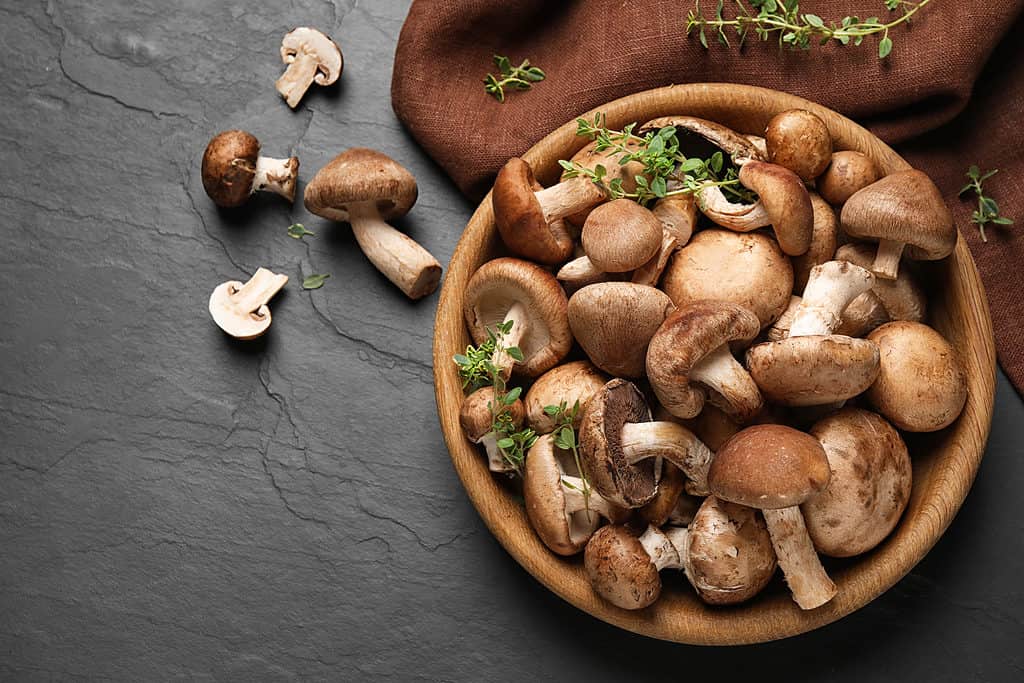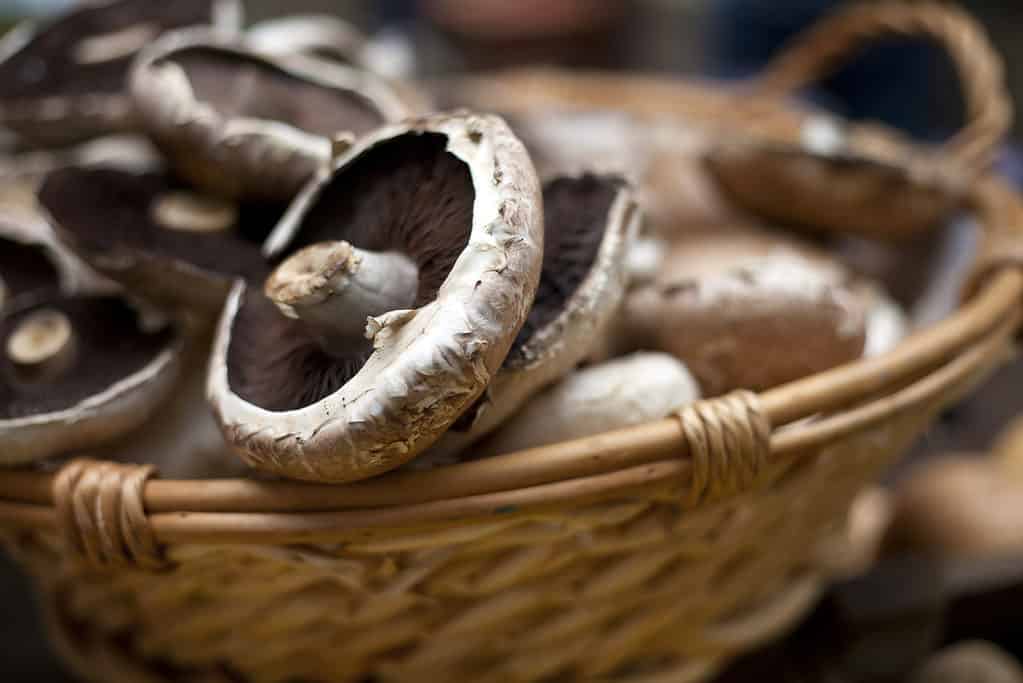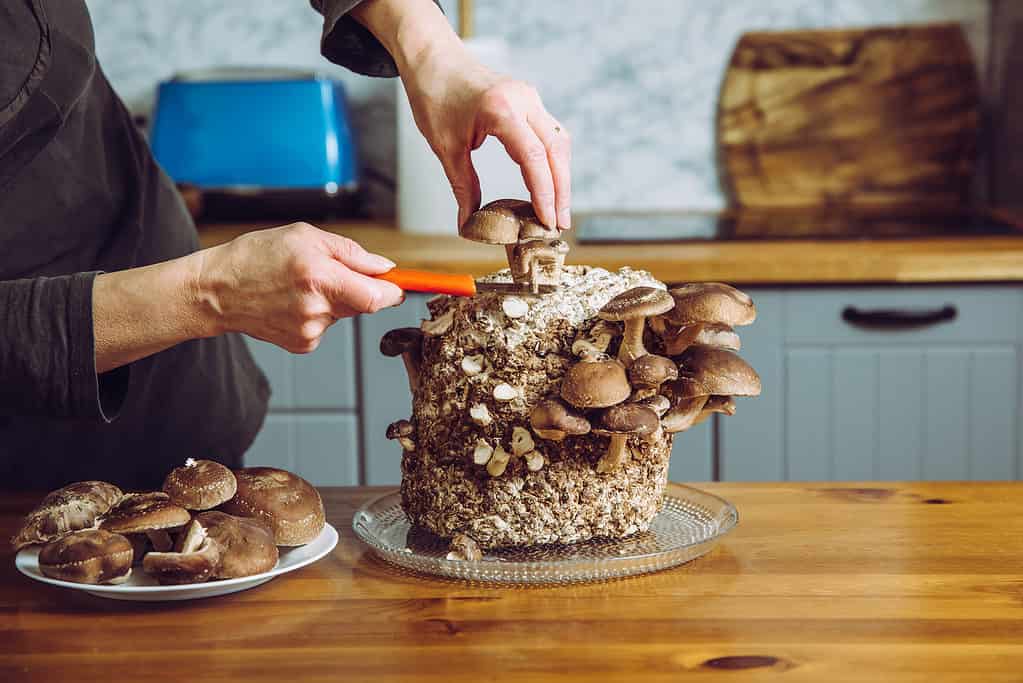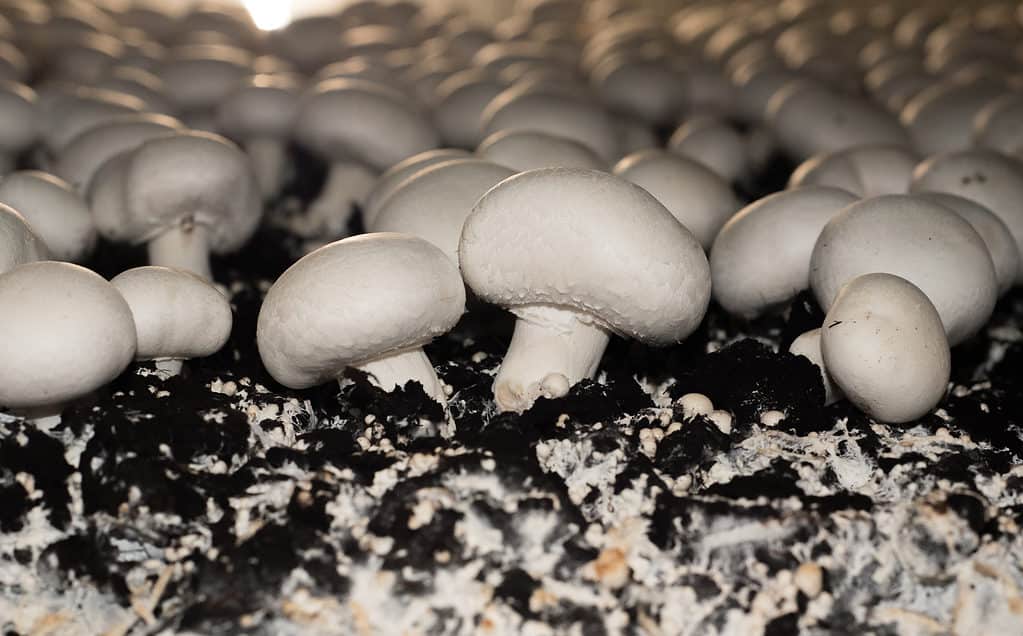If you’re a fan of cultivated, culinary mushrooms, you’re almost certainly familiar with shiitakes and portobellos. So, what are the overlaps and differences between these two popular mushrooms?
In this guide, we’ll cover the fungal classification, morphology, ecological roles, cultivation, and culinary uses of shiitake mushrooms vs. portobello mushrooms.
Alright, let’s jump in!
| Shiitake Mushrooms | Portobello Mushrooms | |
|---|---|---|
| Scientific Name | Lentinula edodes | Agaricus bisporus |
| Native Distribution | Temperate forests of East Asia | Grasslands of Europe, North America, and China |
| Cultivated? | Yes | Yes |
| Basic Stem and Cap Characteristics | Features a reddish-brown cap with white scales, a brown stem, and cream-colored gills. | Features a light to dark brown cap with a white stem and dark brown gills. |
| Ecology | Saprotrophic as white-rot wood decomposers | Saprotrophic- growing in manure and decaying plant material such as lawn thatch. |
| Culinary Uses | Wonderfully savory and widely popular for use in soups, stews, stir frys, and as meat substitutes. Also used in powdered and dried forms. | One of the most common grocery store mushrooms. Used in a wide variety of dishes. Large portobello mushrooms make excellent vegan burgers. |
Shiitake Mushrooms vs. Portobello Mushrooms: Fungal Classification and Native Distribution
While both shiitake and portobello mushrooms are basidiomycetes in the Agaricales order of fungi, they belong to entirely separate fungal families. As basidiomycetes, the spores of these mushrooms develop in the basidia, which are microscopic, (typically) club-shaped organs that bear spores.
The portobello mushroom, Agaricus bisporus, belongs to the Agaricaceae family and is one of about 500 species in the Agaricus genus, which is currently divided into seven subgenera. Agaricus bisporus is almost certainly the most well-known species of the Agaricus genus, and in addition to “portobello”, this species also represents the button mushrooms, criminis, and baby bellas. Traditionally thought of as mushrooms native only throughout Europe and parts of China, a 1995 study confirmed that Agaricus bisporus also has native distribution in the western region of North America.
The shiitake mushroom, Lentinula edodes one of around nine currently recognized species in the much smaller Lentinula genus. This mushroom has over a thousand-year history of cultivation in its native region of East Asia, particularly in China and Japan.
Morphologies
The morphological characteristics of shiitake and portobello are quite distinct from each other, so distinguishing these two culinary mushrooms is rather achievable at the macroscopic level.
Shiitake Morphology

Shiitake mushrooms have a wonderfully meaty, chewy texture and complex, savory, nutty taste.
©New Africa/Shutterstock.com
When young, the cap of the shiitake mushroom is convex with in-rolled margins, and as it matures, it tends to flatten like a disc. For shiitakes, the cap size can range from 2- 5 inches across. The color of shiitake mushroom caps can range from light brown to a deeper reddish-brown, and it often features crackling and rings of white scaling. The cap and stem have a meaty, almost rubbery texture. They also smell quite pleasant and earthy.
Portobello Mushroom

Freshly picked portobello mushrooms in a basket
©Magdanatka/Shutterstock.com
Agaricus bisporus mushrooms are typically advertised as “portobellos” when they are harvested at full maturity. The cap size of portobello typically ranges from 4-6 inches across, representing the largest size sold of Agaricus bisporus. Often, you’ll find portobellos sold only as caps. These mushrooms have dark brown gills, a light brown, scaly cap, a white stipe, and a meaty texture.
Shiitake Mushrooms vs. Portobello Mushrooms: Ecology
Both shiitake and portobello mushrooms fill ecological roles as saprobic mushrooms that decompose organic material. They do differ, however, in the environments they grow in and what they decompose.
Shiitake mushrooms (Lentinula edodes) are distributed throughout hardwood forests in East Asia, especially in temperate and subtropical regions of China and Japan. As wood-inhabiting white-rot fungi, shiitake mushrooms are capable of decomposing lignin, cellulose, and hemicellulose in wood. Although, they preferentially target lignin. White-rot fungi play an important role in both recycling nutrients back into the soil and carbon sequestration.
Agaricus bisporus inhabits grassy areas of Europe, North America, and China. These mushrooms, while not wood-inhabitors, are also capable of breaking down lignin found in the plant matter they decompose such as leaf litter.
Cultivation of Shiitake and Portobello Mushrooms
Both shiitake and portobello mushrooms are widely cultivated, with shiitake currently holding the number 1-2 spot (depending on the source) as the most cultivated mushroom in the world. While Agaricus bisporus is the most common mushroom to find in grocery stores in the US, it sits around the 5th most cultivated mushroom worldwide.
Shiitake Cultivation

Shiitake mushrooms, Lentinula edodes growing in home kitchen.
©FotoHelin/Shutterstock.com
Shiitake mushrooms are typically cultivated in two main ways: through outdoor production on hardwood logs or through indoor production on sterilized hardwood sawdust blocks. Outdoor cultivation on logs takes much longer as the shiitake has to colonize a far denser substrate than with supplemented hardwood sawdust.
Outdoor Cultivation
The process of outdoor cultivation can take between 12-18 months or longer before the first flush, while indoor cultivation can take closer to 2 months before the first flush. However, the benefit of outdoor growing on logs is that you aren’t required to have a laboratory setup and high sterilization practices to grow shiitake. Instead, you can purchase spawn plugs that you then gently tap and seal into drilled holes throughout the log. Because the logs are so dense, most other microbes aren’t able to readily colonize the substrate.
As white-rot fungi that can decompose lignin and cellulose, shiitake mushrooms are a prime candidate for hardwood log colonization. As such, you don’t have to worry nearly as much about competition with other microbes. Besides the timeline taking much longer, the other downside to outdoor production is that the yield per area of the substrate is far lower. Still, some small-scale mushroom production farms can produce enough to meet their customer’s needs by having a large number of logs in production.
Indoor Production
The other main method of growing shiitake is inside on supplemented hardwood sawdust blocks. This method requires an extremely high level of sanitation protocol and sterilizing the substrate. Unlike oyster mushrooms, shiitake mycelium doesn’t aggressively and quickly colonize cellulose-containing substrates. Their mycelium is slower and they require a hardwood-based substrate. This substrate is usually supplemented with nutritious material such as rye berries or bran. It’s a perfect environment for many other types of microbes to quickly colonize. As such, the substrate needs to be sterilized and meticulous hygiene protocols followed to significantly reduce the chances of contamination. With careful cultivation practices, this method results in a much higher yield at a significantly reduced timeline.
Portobello Mushroom Cultivation

White button mushrooms (Agaricus bisporus) growing.
©ArliftAtoz2205/Shutterstock.com
Portobello, criminis, button mushrooms, and baby bellas are all the same Agaricus bisporus species. To produce “portobellos”, growers wait until the mushrooms reach the height of their maturity before harvesting. Thus the caps are larger, meatier, and have a more intense flavor than when they are harvested as buttons (immature phase).
Most commercial growers cultivate Agaricus bisporus in a mix of pasteurized and aerated compost and manure. Once the substrate is colonized, they add a casing layer of sphagnum peat moss to trigger a transition from vegetative growth of the mycelium to reproductive growth of the fruiting bodies. The entire process usually takes about 7-8 weeks from processing the compost-based substrate to harvesting the first flush.
Culinary Uses

Stuffed portobello mushrooms
©zi3000/Shutterstock.com
Both of these mushrooms are widely popular and versatile culinary mushrooms. Shiitake and portobellos are wonderful simply sautéed with garlic, butter, and a dash of pepper and salt. However, you can also use these mushrooms in a variety of other dishes. Please note that we do recommend that either mushroom be cooked.
Shiitake mushrooms are especially popular for their rich, earthy taste and meaty texture. They’re absolutely amazing fresh or dried soups and stews. You can also often find dried shiitake for sale as the drying process intensifies the deep umami flavor of this mushroom. Additionally, shiitakes make an excellent powder that you can add to various dishes for a pop of savory flavor.
Portobellos are one of the best common culinary mushrooms for grilling. Their large cap size and dense, meaty texture make them perfect for throwing on the grill and serving up with veggies. They also make an amazing veggie burger base.
The photo featured at the top of this post is ©
The information presented on or through the Website is made available solely for general informational purposes. We do not warrant the accuracy, completeness, or usefulness of this information. Any reliance you place on such information is strictly at your own risk. We disclaim all liability and responsibility arising from any reliance placed on such materials by you or any other visitor to the Website, or by anyone who may be informed of any of its contents. None of the statements or claims on the Website should be taken as medical advice, health advice, or as confirmation that a plant, fungus, or other item is safe for consumption or will provide any health benefits. Anyone considering the health benefits of particular plant, fungus, or other item should first consult with a doctor or other medical professional. The statements made within this Website have not been evaluated by the Food and Drug Administration. These statements are not intended to diagnose, treat, cure or prevent any disease.
Thank you for reading! Have some feedback for us? Contact the AZ Animals editorial team.






